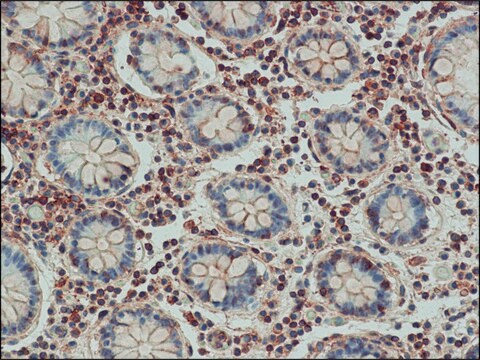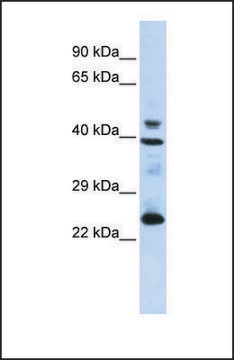MABF1969
Anti-Glutathione Peroxidase 4 Antibody, clone Mab63-1
clone Mab63-1, from mouse, purified by affinity chromatography
Synonym(e):
Phospholipid hydroperoxide glutathione peroxidase cytosolic, cGPx4, PHGPx, Glutathione peroxidase 4, GPx-4, GSHPx-4
About This Item
Empfohlene Produkte
Biologische Quelle
mouse
Qualitätsniveau
Antikörperform
purified immunoglobulin
Antikörper-Produkttyp
primary antibodies
Klon
Mab63-1, monoclonal
Aufgereinigt durch
affinity chromatography
Speziesreaktivität
human, mouse
Verpackung
antibody small pack of 25 μg
Methode(n)
dot blot: suitable
electron microscopy: suitable
immunohistochemistry: suitable (paraffin)
immunoprecipitation (IP): suitable
western blot: suitable
Isotyp
IgG2aκ
NCBI-Hinterlegungsnummer
UniProt-Hinterlegungsnummer
Versandbedingung
ambient
Posttranslationale Modifikation Target
unmodified
Angaben zum Gen
human ... GPX4(2879)
Allgemeine Beschreibung
The cytosolic isoform is ubiquitously expressed at moderate levels in most mammalian cells. On the other hand, mitochondrial and nuclear isoforms are overexpressed in spermatoid cells. Clone Mab63-1 specifically recognizes cGPx4 in human and its ortholog in mouse. However, it does not recognize rat GPx4. GPx4 is a considered to be a moonlighting protein that has been implicated in anti-oxidative defense, gene expression regulation, and programmed cell death, and as a structural protein in spermatogenesis. Homozygous GPx4-deficient mice are reported to die utero before E7.5. Similarly, homozygous mice expressing catalytically inactive GPx4 variants (Sec46Ala/Ser mutant) do not survive beyond the 7th day of embryogenesis. (Ref.: Borchert, A., et al (2010). Immunol. Lett. 133 (2); 85-93).
Spezifität
Immunogen
Anwendung
Entzündung & Immunologie
Immunoprecipitation Analysis: A representative lot detected Glutathione Peroxidase 4 in Immunoprecipitation applications (Borchert, A., et. al. (2010). Immunol Lett. 133(2):85-93).
Immunohistochemistry Analysis: A representative lot detected Glutathione Peroxidase 4 in Immunohistochemistry applications (Borchert, A., et. al. (2010). Immunol Lett. 133(2):85-93; Brutsch, S.H., et. al. (2015). Antioxid Redox Signal. 22(4):281-93).
Western Blotting Analysis: A representative lot detected Glutathione Peroxidase 4 in Western Blotting applications (Brutsch, S.H., et. al. (2015). Antioxid Redox Signal. 22(4):281-93; Borchert, A., et. al. (2010). Immunol Lett. 133(2):85-93).
Dot Blot Analysis: A representative lot detected Glutathione Peroxidase 4 in Dot Blot applications (Borchert, A., et. al. (2010). Immunol Lett. 133(2):85-93).
Electron Microscopy Analysis: A representative lot detected Glutathione Peroxidase 4 in Electron Microscopy applications (Brutsch, S.H., et. al. (2016). J Biol Chem. 291(45):23578-23588).
Qualität
Western Blotting Analysis: 2 µg/mL of this antibody detected Glutathione Peroxidase 4 in lysate of HEK293 cells transfected with Gpx4.
Zielbeschreibung
Physikalische Form
Lagerung und Haltbarkeit
Sonstige Hinweise
Haftungsausschluss
Not finding the right product?
Try our Produkt-Auswahlhilfe.
Lagerklassenschlüssel
12 - Non Combustible Liquids
WGK
WGK 1
Flammpunkt (°F)
does not flash
Flammpunkt (°C)
does not flash
Analysenzertifikate (COA)
Suchen Sie nach Analysenzertifikate (COA), indem Sie die Lot-/Chargennummer des Produkts eingeben. Lot- und Chargennummern sind auf dem Produktetikett hinter den Wörtern ‘Lot’ oder ‘Batch’ (Lot oder Charge) zu finden.
Besitzen Sie dieses Produkt bereits?
In der Dokumentenbibliothek finden Sie die Dokumentation zu den Produkten, die Sie kürzlich erworben haben.
Unser Team von Wissenschaftlern verfügt über Erfahrung in allen Forschungsbereichen einschließlich Life Science, Materialwissenschaften, chemischer Synthese, Chromatographie, Analytik und vielen mehr..
Setzen Sie sich mit dem technischen Dienst in Verbindung.








